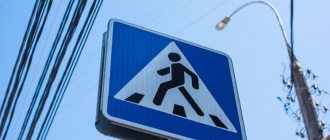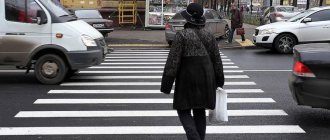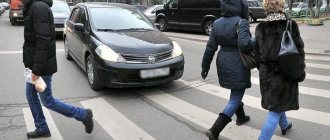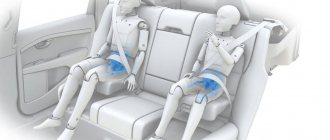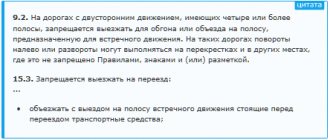Good afternoon, dear reader.
This article will focus on not giving right of way to pedestrians. This violation is quite popular, and traffic police officers often conduct raids at pedestrian crossings.
Let's look at situations in which pedestrians have the right of way, as well as the penalties that can be imposed on the driver. Let me remind you that the last time the penalty for not allowing pedestrians, cyclists or other road users to pass was increased on November 10, 2017 .
Last modified
The method of allowing pedestrians to pass, according to clause 14.1 of the traffic rules, has changed with the latest innovation on November 14, 2014.
Previously, the Rules stated that the driver is obliged to “give way” to a pedestrian, but now there is an obligation to “give way”, and you will understand what the difference is below. Change in clause 14.1 of the Rules
| Was | New edition |
| 14.1. The driver of a vehicle approaching an unregulated pedestrian crossing must slow down or stop before the crossing in order to allow pedestrians crossing the roadway or entering it to cross. | 14.1. The driver of a vehicle approaching an unregulated pedestrian crossing is obliged to give way to pedestrians crossing the road or entering the roadway (tram tracks) to cross. |
Fine for not allowing a pedestrian to pass in 2021
Let's consider article 12.18 of the Administrative Code:
Article 12.18. Failure to give priority in traffic to pedestrians or other road users
Failure to comply with the requirement of the Traffic Rules to give way to pedestrians, cyclists or other road users (except for vehicle drivers) who have priority in traffic, -
shall entail the imposition of an administrative fine in the amount of one thousand five hundred to two thousand five hundred.
In 2021, the fine is 1500 - 2500 rubles .
The selection of a fine in the specified range is made by a traffic police officer. In doing so, he must take into account mitigating and aggravating circumstances. Thus, if the driver committed a violation for the first time, then, as before, he will receive a minimum fine of 1,500 rubles.
In addition, I suggest you download and print the current table of fines:
Traffic police fine table
Comments and clarifications to clause 14.1 of the traffic rules
So, we’ll start with how to allow pedestrians to pass at the crossing in 2021.
How to give way to a pedestrian?
As can be seen from the quote in paragraph 14.1 above, pedestrians must give way. Until November 2014, there was a discrepancy between the traffic rules and the Code of Administrative Offenses: the first ordered pedestrians to let pass, the second punished for failure to yield to the road. Therefore, they were brought into compliance with a corresponding change. But what was the catch?
The problem is that the term pass is not described in any way in the Traffic Rules. But there is a definition of giving way in the new traffic regulations.
The driver must not interfere with the pedestrian. According to clause 1.1 of the Rules, this means that he should not force him to change the speed and/or direction of movement precisely through his own fault. Please note that in the context of giving way, an important condition is: your movement trajectories with the pedestrian must intersect simultaneously in space and time - that is, if you do not give way, you will hit him or force the pedestrian to stop/run away. In any case, on the initiative of the pedestrian, he changes the speed and trajectory, or you use the body of your car to change these physical properties, clause 14.1 of the traffic rules will be violated.
Thus, according to the rules, pedestrians should be allowed to pass like this:
- You approach the crossing and see that the pedestrian has already started crossing. If he is not yet on the roadway, then the driver is not obligated to give way to him.
- You are obliged to stop or slow down so that the pedestrian crosses the road without changing either the trajectory or speed because of you. Please note that if he changed his mind about crossing and thus changed the trajectory and speed, it is not your fault. But if you are afraid of you approaching sharply, then options are possible, alas, at the discretion of the inspector.
- As soon as the pedestrian has left the intersection of your trajectories, you can drive. You have no obligation to wait until he leaves the roadway completely. Let us draw your attention once again - there is an obligation to give way, and it is fulfilled.
In the diagrams below, you did not interfere with the pedestrian, and fully complied with the requirement of paragraph 14.1.
- If you pass without interfering with a pedestrian when he crosses far from you on the other side of the road:
- If you pass before the pedestrian has completed the crossing, but let him pass:
- If the pedestrian changed the trajectory and/or speed of movement on his own initiative:
But this is a theory, but in practice...
If a camera has recorded a pedestrian’s failure to pass, then the fact of giving way to him does not matter - if you are at a pedestrian crossing and the pedestrian is on the roadway, a fine will be issued. This is a significant shortcoming today (more precisely, it is probably a trick by TsAFAP, which is why such fines need to be appealed).
But in practice, the traffic police inspector will try to fine you in any case if the pedestrian is already on the road. Alas, the traffic police officers play on drivers’ ignorance of the rules of the road, and this is their most common “conception.”
Therefore, the above comments will only help you if you have a video recorder, the recording from which can confirm the absence of an obstacle created for a pedestrian and compliance with clause 14.1 of the traffic rules, and as a result, avoid a fine for not allowing a pedestrian to pass. Just inform the inspector that you have a registrar and your intention to appeal the fine if he still insists on not allowing you to pass. Rest assured, he knows exactly the interpretation of 14.1.
If there is no registrar, then we explain the following:
- witness testimony will be strong if the witnesses are not your relatives, not passengers,
- the inspector is obliged to comprehensively consider the case of an administrative violation (Article 26.11 of the Administrative Code), which means that, if possible, he is obliged to involve the pedestrian himself as a witness,
- The Supreme Court of the Russian Federation not so long ago ruled that a protocol on a violation alone is not enough, and this document in itself is not evidence, therefore the inspector needs evidence of the pedestrian’s refusal to pass (when appealing, it is better to remind about this court decision).
According to the new rules of 2021, the inspector has the right to immediately issue a resolution. And if you do not agree with the violation, then he is obliged to draw up a protocol. In it, indicate the inspector’s violations. Also, if he did not explain to you Article 51 of the Constitution (no one is obliged to testify against himself or his immediate relatives) and Article 25.1 of the Administrative Code (on the right to get acquainted with the case materials), then also indicate this. If the inspector refuses to draw up a protocol, you can indicate this in the resolution.
How to give way
In order to prevent a situation in which a driver may be fined for not allowing a pedestrian to pass, the following algorithm of actions should be followed:
- in front of the “Pedestrian Crossing” road sign or corresponding markings, you must reduce your speed;
- inspect the sidewalk for pedestrians heading towards the crossing;
- assess the situation, the distance from the car and pedestrian to the zebra crossing, the speed of the person and the car;
- if the analysis shows that the car will have time to cross the zebra crossing faster than a pedestrian will step on it, continue driving while maintaining or increasing speed;
- otherwise, you must stop and wait for the pedestrian to cross the road.
If the pedestrian has already crossed the lane in which the car is located, the driver can resume movement without waiting until he reaches the opposite edge of the road.
Also, if the road has more than 2 lanes in each direction, then the driver can continue driving if the distance between his car and the pedestrian is greater than or equal to the width of 2 lanes.
Arbitrage practice
- The Altai Regional Court upheld the driver’s complaint against the traffic police inspector’s ruling that he did not interfere with a pedestrian on the road; the inspector did not draw up a report, despite challenging the violation of clause 14.1, and the witness was not interviewed. To prove his case, the driver provided a video recording. The court took into account that the driver complied with the requirement to give way to the pedestrian, although both were crossing the roadway at the same time.
- But another court upheld the traffic police officer’s fine, despite the driver’s same arguments.
Is it possible to appeal a fine?
In accordance with the law, drivers can challenge a fine imposed by a traffic police officer for failure to allow a pedestrian to pass. In order to appeal the penalty and prove your case, it is recommended to provide the judge with testimony or video recordings. You can also point out the following circumstances:
- insufficient visibility;
- adverse weather conditions;
- unsatisfactory condition of the road surface;
- distracting advertising;
- inability to estimate the speed of a pedestrian.
The punishment may be mitigated by circumstances falling under Art. 2.7 Code of Administrative Offenses of Russia “Extreme Necessity”. You can refer to this article if, for example, at the time the violation was committed, the driver did not give way because he was taking a child to the hospital. The presence of other facts may also reduce the fine. According to Art. 4.2 of the Administrative Code these include:
- voluntary admission of guilt;
- remorse of the offender;
- voluntary compensation and correction of the situation;
- the heat of passion;
- pregnancy;
- presence of a young child;
- participation in the study of the circumstances of the incident.
To appeal administrative penalties you are given 10 days from the date of drawing up the protocol.
In order to avoid a fine, you must carefully monitor the road and always, if possible, give way to pedestrians.
Cameras for automatic recording of offenses
For several years now, traffic cameras at pedestrian crossings have been tested in the Russian Federation. If there is less than 1 lane between a person and a car, there is a violation. Then the driver receives a fine.
There are 2 systems for recording traffic violations: “Avtouragan” and “Olvia”. The first system identifies people on the edge of the road and then tracks their movement. A smart camera determines whether the driver or the pedestrian is violating traffic rules. So that the system does not consider that the driver is at fault, it is necessary to brake as soon as the person enters the zebra crossing.
The Olvia system records cars, measuring their speed and analyzing the trajectory of cars and people. The violation is recorded, 4 photographs are taken, in which the car and its registration plate are visible separately.
We talked in detail about how much compensation or punishment to demand if you were hit by a car at a pedestrian crossing in this article.
Despite the fact that the “smart” systems themselves determine who is to blame for the violation, they still only form the materials of the incident, and the task of the traffic police inspectors is to interpret what happened.
Driver Responsibilities
90% of the rules prescribed by traffic rules are devoted to the driver’s duties.
Also, the interaction between pedestrians and drivers is indirectly discussed in other sections. Thus, the rules for driving through intersections clearly state that before starting to move or make a turn, the driver must allow all pedestrians on the roadway to complete the crossing.
Turning at an intersection
According to paragraph 13.1, when making a turn, the driver must not interfere with road users who are on the road.
It is important to remember that the driver must always give way to pedestrians when turning. This even applies to situations where:
- there are no special markings for pedestrians;
- the driver is on the main road;
- The traffic light signal allows you to make a turn;
- The red light is on for pedestrians.
The only exception is the simultaneous absence of striped markings and driving straight at the intersection.
Didn't let a pedestrian pass, how to prove innocence?
Let's assume that the driver did not allow the pedestrian to pass, who himself caused the accident. You can prove your non-involvement using the following algorithm:
- Wait for the inspector to show his ID and introduce himself. The reason for the stop must be stated.
- It is imperative to require the official drawing up of a protocol and taking testimony from the pedestrian.
- Next, you can explain to the pedestrian that he himself provoked the accident, that it was dangerous to jump out of the crossing in front of a speeding car. The inspector will also have to issue a fine for the pedestrian.
- That's it, now the pedestrian has become a witness. Now, in order not to get a fine, he will try to prove that the driver did not interfere with him.
- If the inspector did not call the injured pedestrian, citing the fact that he had already left, then it turns out that there is no corpus delicti. After all, without a pedestrian, it is unlikely that it will be possible to prove that the driver did not give way to him. Unless, of course, there is photo or video recording of violations at the intersection.
How to give way to a pedestrian at a crossing - watch the video below!
View more articles from the category: Fines
Did you like the article? Share with friends:
Crosswalk
The second name for a pedestrian crossing is zebra crossing. It is designed to safely move people across the roadway. Requirements for the placement of a zebra crossing and its marking on the road surface are prescribed at the legislative level. It can be located on the site of either a controlled crossing with a traffic light or an unregulated one.
There should be special identification marks nearby:
- Road sign 1.22 – approaching a zebra crossing.
- Sign 5.19 – pedestrian crossing.
- Horizontal marking 1.14 – designation of the area where a person crosses the road.
A zebra crossing runs along the road and tram line. Accordingly, tram drivers must also anticipate the likelihood of pedestrians entering the rails and reduce speed in advance to ensure that the tram can come to a complete stop. On large roads, crossings are marked with a wider zebra crossing and may have signs indicating the direction of people's movement (marking 1.14.2).
Important! If there are no crossings for pedestrians in the visible zone, then a person has the right to cross the road at any place. Before starting to move, he must make sure that his actions are safe and that there are no approaching cars.
The pedestrian left the scene of the accident
How should a driver behave? Situations occasionally occur when a pedestrian who has been hit goes away on his own, and after some time the driver is stopped and charged with a violation on the basis of Part 1 or 2 of Article 12.24 of the Code of Administrative Offenses of the Russian Federation.
Therefore, regardless of the condition of the victim and the driver, the following rules must be observed:
- Stop. Get out of the car, put up a warning triangle and invite the pedestrian to call an ambulance.
- If he refuses and is about to leave, ask him to write a receipt saying that having been in an accident with such and such a car, I have no complaints against the driver and do not need medical assistance. It is also necessary to indicate the name, address and telephone number of the victim.
- Next, we call the traffic police and call an inspector.
- Report this incident to your insurance company.
- Look around. There may have been witnesses. Get their testimony.
- When the inspector arrives, inform him about what happened, attach a receipt to the protocol, draw up a protocol and a diagram of the accident. If you have a video recorder, also indicate this in the protocol.
Do not neglect to call the traffic police officer. If you flee the scene of an accident, you will be subject to deprivation of your license. Also, do not transport the victim yourself, call an ambulance, otherwise this will be regarded as leaving the scene of an accident.
Legal consultation
Get qualified help right now! Our lawyers will advise you on any issues out of turn!
To get a consultation
2. Leaving by the driver, in violation of the Traffic Rules, the scene of a traffic accident in which he was a participant, in the absence of signs of a criminal offense, entails deprivation of the right to drive vehicles for a period of one to one and a half years or administrative arrest for a period of up to fifteen days.
Part 2 of Article 12.27 of the Code of Administrative Offenses of the Russian Federation
Do not negotiate with the victim for damages. This can turn into long-term payments, and you are also not insured against the fact that they do not report this to the police.
Pedestrian in a yard or residential area
Remember one single rule: when entering the yard, the right of way is automatically transferred to the pedestrian.
In a residential area, that is, in an area whose entrances and exits are indicated by signs 5.21 and 5.22, pedestrian movement is permitted both on sidewalks and on the roadway. In residential areas, pedestrians have the right of way, but they must not unreasonably interfere with vehicular traffic. (as amended by Decree of the Government of the Russian Federation dated December 14, 2005 N 767)
Clause 17.1 of traffic rules
Therefore, if you are driving into a residential area or into a yard, you are required to give way to other road users.
17.3. When leaving a residential area, drivers must give way to other road users. 17.4. The requirements of this section also apply to courtyard areas.
Clause 17.3 and 17.4 of traffic rules
